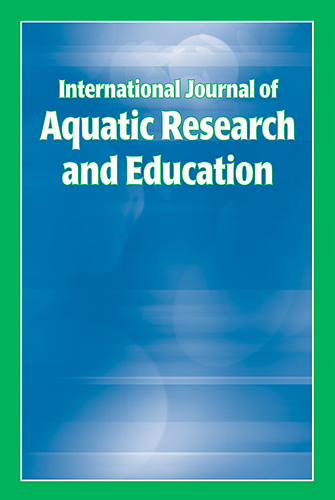Home > Journals > IJARE > Vol. 11 > No. 4 (August 2019)
Volume 11, Number 4 (August 2019) Selected Papers from 2018 Lifesaving Foundation Drowning Prevention and Rescue Research Conference
Special Issue Editor Notes
Welcome to Volume 11, Issue 4 of the International Journal of Aquatic Research and Education. This is a special issue featuring selected papers from the 2018 Lifesaving Foundation Drowning Prevention and Rescue Research Conference.
The International Journal of Aquatic Research and Education collaborated with the Lifesaving Foundation on two special issues during 2018-2019. The first, Volume 11, Issue 2, published 30 abstracts and other informational material from the 2018 conference.
This current issue (#4) features full length peer reviewed papers authored by some self-selected presenters at the 2019 Conference. These papers represent a wide variety of topics and approaches to drowning prevention and rescue that originally were presented at the Conference in the form of oral presentations.
This special issue owes a debt of gratitude to the authors for their patience during the protracted review process as well as to the three special editors who recruited reviewers and provided initial editing of the papers. Those special editors were Robert K. Stallman (Norway), Kristine deMartelaer (Belgium) and Richard Franklin (Australia). Many thanks for your editorial assistance!
Research Papers
The first research paper, "The Consequences of Cold Water Immersion: Impacts and Treatment," features collaborative research with the Irish Navy to study the impact of very cold water on persons immersed in the water for up to an hour. Lead author, Patrick Buck, along with his co-authors, Commander William Roberts and Commander Ken Minehane, details a funded research project that explored both the immediate impact of cold water and the human body's complex physiological responses following removal from the water. It is an interesting read that should be a 'must' for anyone involved in cold water rescue.
The second research paper in this special issue, "First Responders' Narratives of Drowning: Perceptions of Family and Community Impacts and Policy Implications," comes from John Wells, Ph.D., Michael Bergin, John Connolly (of the Lifesaving Foundation), and Suzanne Denieffe, Ph.D., colleagues at the Waterford Institute of Technology, Republic of Ireland. This detailed study examined the consequences of drowning on victims' family and the broader community.
Educational Articles
The first educational article, "How to Help People Float," was authored by Ms. Andrea Andrews of the United Kingdom. I believe readers will find the educational article to be absolutely fascinating. Andrea brings her experiential study of floating as a primary means to prevent drowning to a whole new level of consciousness.
The second educational article, authored by Filip Roelandt, from the University of Ghent in Belgium, entitled "From Treading Water to Swimming Uphill: A Comprehensive and Innovative Assessment Program for Teaching Swimming Belgian Primary Schools," describes how they have reformed the teaching of swimming in schools across Belgium using innovative play practices as well as a fascinating color-coded evaluation and achievement system. Readers with interest in instructional aquatics will find this paper a very worthwhile read.
The third educational paper, "Validating Water Safety Competence" was authored by Shayne Baker, DProf, and recent Ireland Medal recipient. Shayne describes an exemplar program, Downs Little Lifeguards (DLL), from Queensland, Australia, that aims to not only teach swimming, but to make certain that the children in the program are competent in real world aquatic environments. The paper raises some questions about whether our swimming and water safety programs have sufficient validity to really help us reduce worldwide drownings.
The fourth educational paper of this special issue, "The Assessment of Swimming and Survival Skills: Is Your Programme Fit for Its Purpose," was authored by Paolo DiPaola of Swim Ireland. His paper addresses issues related to valid and reliable measurement of swimming in order to improve our understanding of how and whether swimming programs in fact address drowning prevention.
The fifth educational and final paper in this issue, "Crises in the Aquatic Profession," was authored by Robert Keig Stallman of Norway. Bob's paper addresses his perceptions of some challenges to preventing drowning emanating from deficiencies in swimming instructional programs and swimming instructors globally. It deserves a close read.
I hope you enjoy these articles from the 2018 Lifesaving Foundation conference. They are designed to enhance our understanding surrounding drowning and drowning prevention and hopefully to stimulate discussion and further research.
Research Articles
The Consequences of Cold Water Immersion: Impacts and Treatment
Patrick J. Buck Ph.D., Commander William Roberts, and Commander Ken Minehane
First Responders' Narratives of Drowning: Perceptions of Family and Community Impacts and Policy Implications
John Wells PhD; Michael Bergin PhD; John Connolly B.Ed., MA in Ed.; and Suzanne Denieffe PhD
Education Articles
How To Help People Float
Andrea Andrews
Validating Water Safety Competence
Shayne D. Baker OAM DProf
The Assessment of Swimming and Survival Skills: Is Your Programme Fit for Its Purpose?
Paolo Di Paola
Crises in the Aquatic Profession
Robert Keig Stallman
